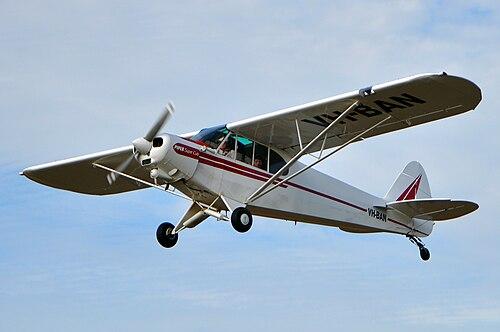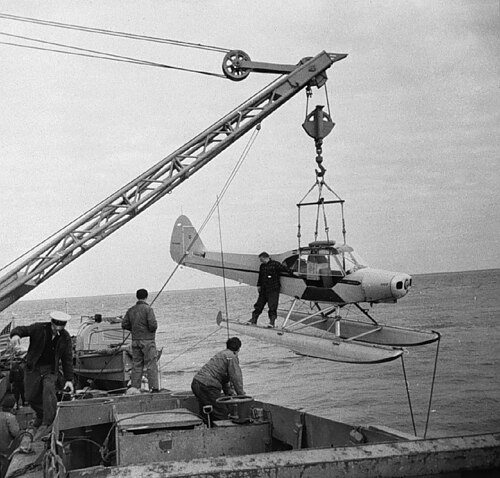The Piper PA-18 Super Cub is a two-seat, single-engine monoplane. Introduced in 1949 by Piper Aircraft, it was developed from the PA-11 Cub Special, and traces its lineage back through the J-3 Cub to the Taylor E-2 Cub of the 1930s. In close to 40 years of production, over 10,000 were built.[1] Super Cubs are commonly found in roles such as bush flying, banner towing and glider towing.
While based on the design of the earlier Cubs, the addition of an electrical system, flaps (3 notches), and a considerably more powerful engine (150 hp), made it a very different flying experience. Although the "standard" Super Cub was fitted with a 150-horsepower (112 kW) Lycoming engine, it is not uncommon to see them equipped with a 160-horsepower O-320-B2B, or even 180 horsepower (134 kW) Lycoming O-360 powerplant. The high-lift wing and powerful engine made the Super Cub a prime candidate for conversion to either floatplane or skiplane. In addition, the PA-18A (an agricultural version) was produced for applying either dry chemical or liquid spray.
The Super Cub retained the basic "rag and tube" (fabric stretched over a steel tube frame) structure of the earlier J-3 Cub.

The first true "Super" Cubs had flaps, dual fuel tanks, and an O-235 Lycoming engine producing about 108 hp (115 hp for takeoff only). However, a 90 hp Continental variant without flaps and without the optional second wing tank was available. Their empty weight was, on the average, 800-1000 pounds with a gross weight of 1,500 lb. These Cubs would take off in about 400 feet (at gross weight) and land in about 300 feet using flaps. The Super Cub is renowned for its ability to take off and land in very short distances. The first Super Cubs were going to be offered with a unique four-wheel tandem main landing gear designed for landing and takeoff from rough terrain, but this was replaced with conventional landing gear.[2][3] The O-290 Lycoming powered Cubs (135 hp) followed and would take off in about 200 feet (61 m). The landing distance remained the same at about 400 feet (120 m), or 300 feet (91 m) using flaps. With the use of the Lycoming O-320 at 150-160 hp, the Cub's allowable gross weight increased to 1,750 lb while retaining the capability of a mere 200 feet (61 m) required for takeoff.
The PA-18 has developed a very dedicated following in the bush-flying community, and many modifications have been developed for it, to the point where it is quite rare to find an original, completely stock Super Cub. Modifications include extended baggage compartments (reaching farther back into the fuselage, or even two-level baggage compartments in the top and bottom of the rear fuselage), external luggage pods, fuel pods, lumber racks for carrying construction materials into unimproved bush runways. Also the removal of header tanks, larger 24 or even 30 gallon wing fuel tanks, extended main landing gear for better ground clearance of the propeller, strengthened tailwheel springs, the addition of a small third passenger seat in the luggage area and lightweight generators and starters. Also various different mount areas for the battery (to move the weight forward, and reduce tail weight to shorten takeoff distance), various vertical stabilzer shapes to increase surface area, lengthened flaps, various wingtip designs, vortex generators on the leading edge of the wings, movement of the electrical panel from the right wing root to the dashboard to reduce fire hazard during a crash, and even the addition of a constant-speed propeller. Above all, the most common modification is the addition of "bush wheels" (themselves said to be direct descendants of Alvin Musselman's 1920s-origin "airwheel" tires used on the original Piper J-3), large, soft, low pressure balloon-tires designed to absorb impacts from rocks and boulders, and to not sink into sand or other soft surfaces, ideal for off-runway landings.
PA-18 Super Cub
- Argentine Air Force
- Argentine National Gendarmerie[9]
- Austrian Air Force
 Belgium
Belgium - Belgian Army
- Cyprus Air Command
- Federal German Luftwaffe
 Greece
Greece - Greek Army[10]
- Imperial Iranian Air Force
- Italian Army[8][11]
 Israel
Israel - Israeli Air Force[12]
- Japan Ground Self-Defense Force[8]
 Katanga
Katanga - Force Aérienne Katangaise[13]
- Netherlands Air Force[14]
- Nicaraguan Air Force
- Royal Norwegian Air Force[15]
- Portuguese Army
- Portuguese Air Force
- Swedish Army[16]
- Swiss Air Force
- 4 PA-18-150 served with the Swiss Airforce, as V-653 to V-656, from 1964 to 1975. V654 became HB-PAV, V655 HB-PAW, V656 HB-PAX.
- Turkish Army[7]
- Uruguayan Navy[17]
- United States Air Force[7]
- United States Army[7]
- Alaska State Troopers
- U.S. Fish and Wildlife Service, Alaska
- U.S. Border Patrol Southwest Border
Data from Jane's All The World's Aircraft 1976-77 [18]
General characteristics
- Crew: 1
- Capacity: 1 passenger
- Length: 22 ft 7 in (6.88 m)
- Wingspan: 35 ft 2+1⁄2 in (10.732 m)
- Height: 6 ft 8+1⁄2 in (2.045 m)
- Wing area: 178.5 sq ft (16.58 m2)
- Aspect ratio: 7:1
- Airfoil: USA 35B MOD
- Empty weight: 930 lb (422 kg)
- Max takeoff weight: 1,750 lb (794 kg)
- Fuel capacity: 36 US gal (30 imp gal; 140 L)
- Powerplant: 1 × Lycoming O-320 air-cooled flat four engine, 150 hp (110 kW)
Performance
- Maximum speed: 130 mph (209 km/h, 113 kn)
- Cruise speed: 115 mph (185 km/h, 100 kn) (75% power)
- Stall speed: 43 mph (69 km/h, 37 kn) (flaps down)
- Never exceed speed: 153 mph (246 km/h, 133 kn)
- Range: 460 mi (740 km, 400 nmi)
- Service ceiling: 19,000 ft (5,800 m)
- Rate of climb: 960 ft/min (4.9 m/s)
- Takeoff distance to 50 ft (15 m): 500 ft (152 m)
- Landing distance from 50 ft (15 m): 725 ft (221 m)
Related development
- Piper J-3 Cub
- Piper PA-11 Cub Special
- Taylor Cub
Aircraft of comparable role, configuration, and era
- Aero Boero AB-95
- American Champion Scout
- Aviat Husky
- CubCrafters CC11-160 Carbon Cub SS - 180hp Light Sport
- CubCrafters CC18-180 Top Cub - certified modern version
- Light Miniature Aircraft LM-5 - copy of the PA-18
- Super 18 Model S18-180
- John Andrade, U.S. Military Aircraft Designations and Serials since 1909, Midland Counties Publications, 1979, ISBN 0-904597-22-9
- Peperell, Roger W. and Colin M. Smith. Piper Aircraft and their forerunners. Tonbridge, Kent, England:Air-Britain, 1987, ISBN 0-85130-149-5
- Steinemann, Peter. "Protector of the Plate". Air International, Vol. 42, No. 2, February 1992. pp. 73-78. ISSN 0306-5634.
- Taylor, John W. R. Jane's All The World's Aircraft 1967-68. London: Sampson Low, Marston & Company, 1967.
- Taylor, John W.R. Jane's All The World's Aircraft 1976-77. London: Jane's Yearbooks, 1976, ISBN 0-354-00538-3.
- Wheeler, Barry C. "World Air Forces 1974". Flight International, Vol. 106, No. 3414. August 15, 1974. pp. 167-190.
- SuperCub.Org - Super Cub Enthusiast Group with information and many photos



